卢萨蒂亚
——东德后矿业景观,萨克森州,德国
罗尔夫·库恩 文/Text by Rolf Kuhn
尚晋 译/Translated by SHANG Jin
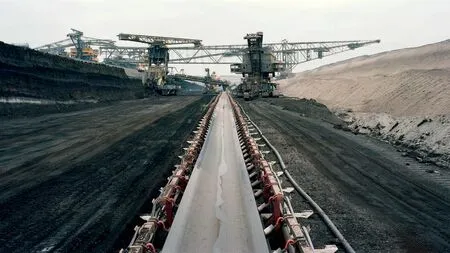
1 韦尔措露天矿/The opencast-mine Welzow(摄影/Photo: Uwe Jacobshagen)
卢萨蒂亚是毗邻波兰的乡村地区,拥有德国第二大褐煤矿区。采矿在这里有150 年的历史,预计在2038 年彻底关闭。
如果今天还想看到有巨大排矸桥作业的露天矿,可以到韦尔措镇北边的高地上去(图1)。一大片经耕作的土地四周是重新培育出来的景观,那里还有一处坡地葡萄园“沃尔肯贝格”(以一处开采地命名),出产上乘白酒。还有一个例子是大雷申湖的葡萄园(图2b)。
大部分煤矿,包括煤球厂、焦化厂和发电厂都在1990 年代德国统一后关闭。随后它们被拆除和翻新,并由卢萨蒂亚与中德矿业管理公司(LMBV)改作新用。
此外,皮克勒亲王郡国际建筑展(IBA)从2000 年举办到2010 年,用引人注目的设计赋予了景观中新开发部分前所未有的魅力。建筑展的工作成员相对较少,却一心一意,成功协调实现了30个后矿业设计(图3)。
这个后矿业景观有大约20 片由旧矿坑形成的湖,它的争议之处引人关注。这个景观周围的许多居民都对这种业已衰败的工业漠不关心,而渴望一座看上去自然天成的湖水景观。但IBA 代表的观点截然相反。他们不想要冰川湖区的复制品,而是一处具有真实性的景观。不否定过去,而是证明即使人造景观也可以惹人喜爱、引人入胜。
这是通过保护、翻新和改造工业文化的最佳见证来实现的,并以此突出了景观的特征和吸引力,并将遗产的本源娓娓道来。实例则包括利希特费尔德的大型F60 采矿桥(作为游客矿井和声光雕塑,图4)、劳赫哈默原焦化厂的塔式生物滤池(图5、6)、普莱萨发电厂(图7)以及杜姆斯多夫的路易丝煤球厂(图8)。森夫滕贝格附近布里斯克的马尔加田园城市也再度成为吸引人的宜居之地(图9)。
不过,与此同时,这个新景观被我们时代的特征塑造出来。它的品质与独特属性将在确定之后让人们去体会。使之成为现实的,一方面是每座湖周围数千米的新自行车和滑板道,以及将10 片中心湖连接起来的12 条通航运河(有的带船闸,图10)。另一方面,为卢萨蒂亚湖区和我们时代特别设计的建筑突出了湖水的边界。它们都是国际竞赛的成果。例子包括大雷申的IBA 台地(图2a-e)、森夫滕贝格码头(图11、12),以及塞德利茨湖与盖尔斯瓦尔德湖之间运河上的地标(锈甲,图13、14)。
此外,许多湖面上都有漂浮建筑(图15)。它们体现出该地区的工程设计和创造精神,并将由勃兰登堡理工大学科特布斯-森夫滕贝格校区的漂浮建筑研究所进一步深化,以期成为这里和世界各地水景的创新之作。□
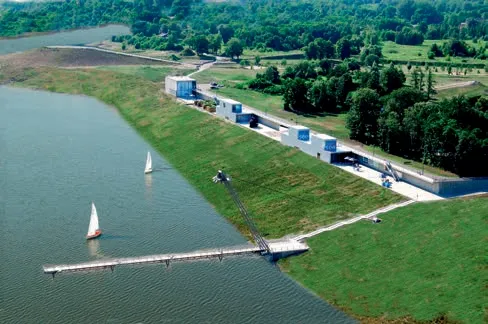
2a IBA大雷申湖坡地。来自美因河畔法兰克福的建筑师费迪南德·海德在国际比赛中为皮克勒亲王郡国际建筑展的信息和展览中心设计了这一形式/IBA Terraces Großräschen.The architect Ferdinand Heide from Frankfurt am Main designed the form for the information and exhibition centre of the IBA Fürst-Pückler-Land in an international competition(图示/Illustration: Professional photo Kliche)
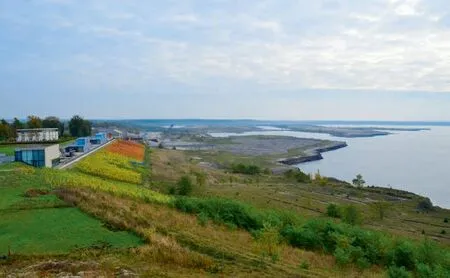
2b IBA坡地葡萄园/The IBA Terraces with vineyard

2c IBA大雷申湖坡地鸟瞰,显示了城市与景观环境/Aerial view of the IBA Terraces at the lake Großräschen, showing the urban and landscape context(摄影/Photo: Professional photo Kliche, 2009)


2d.2e 费迪南德·海德对IBA坡地的设计效果/Visualisations of the IBA Terraces by Ferdinand Heide
Lusatia is a rural region on the border with Poland and home to Germany's second largest lignite mining district. Mining has been in operation here for 150 years and is due to close definitively in 2038.
If you still want to see an opencast mine with a huge conveyor bridge in operation today,you can do so at a vantage point on the northern edge of the town of Welzow (Fig. 1). A large area of ploughed earth is surrounded by already recultivated landscape, to which even a vineyard slope"Wolkenberg" (named after an excavated place)belongs, which delivers a very good white wine.Another example is the vineyard at the lake of Großräschen (Fig. 2b).
Most of the coal mines including briquette factories, coking plants and power stations were closed down in the 1990s after the reunification of Germany and were dismantled, renovated and prepared for new uses by the company "Lausitzer und Mitteldeutsche Bergbauverwaltungsgesellschaft"(LMBV).
In addition, the International Building Exhibition (IBA) Fürst-Pückler-Land, which ran from 2000 to 2010, was to lend new appeal to the newly usable parts of the landscape with an attractive design. The building exhibition worked with relatively few members and civic commitment. It coordinated 30 projects of post-mining design (Fig. 3).
What is attractive for this post-mining landscape, with some 20 lakes stemming from former mines, was controversial. Many inhabitants of this landscape did not want to know anything more about the now dilapidated industry and wished for a natural looking lake landscape. The IBA representatives had a completely different view.They did not want an unreal copy of glacial lake areas, but a landscape with authenticity, which does not deny its past and shows that even a man-made landscape can be lovable and attractive.
This has been achieved by preserving,renovating or retrofitting the best testimonies of industrial culture, thus strengthening the character and attractiveness of the landscape and telling of its origins. Examples are the large F60 mining bridges at Lichterfeld (as a visitor mine and light and sound sculpture, Fig. 4), the bio-towers of the former coking plant in Lauchhammer (Fig. 5, 6), the Plessa power plant (Fig. 7) and the Louise briquette factory in Domsdorf (Fig. 8). The garden city of Marga in Brieske near Senftenberg also became an attractive place to live in (Fig. 9).
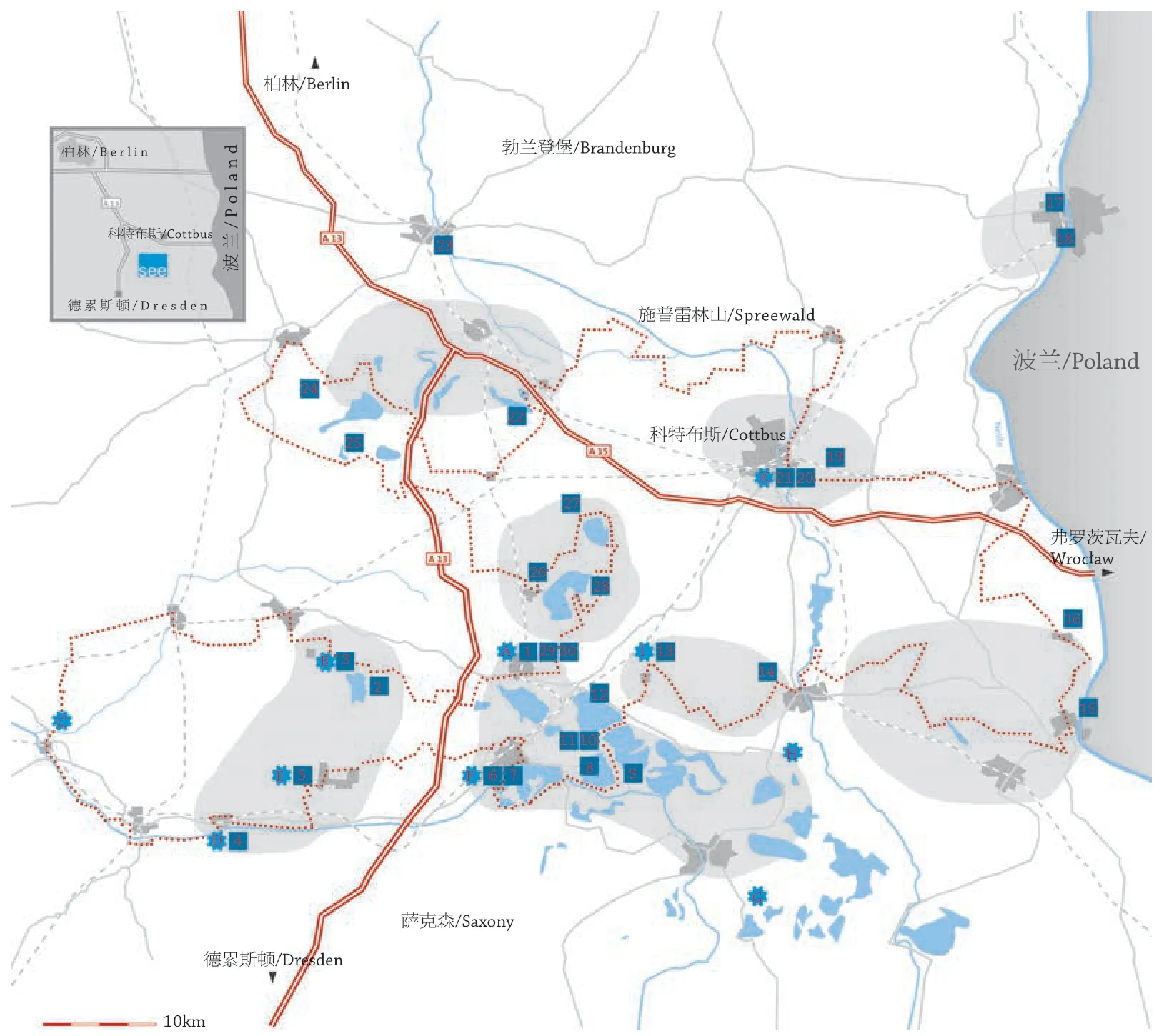
3 IBA(2000-2010)总平面图“皮克勒亲王郡”标示出30处IBA项目/Site plan of the International Building Exhibition(2000-2010) "Fürst-Pückler Land" showing the 30 IBA projects
IBA项目/IBA Projects
1-IBA起始点大雷申湖南部/IBA Start Site Grossräschen-South
2-F60游客矿井/F60 Visitors' Mine
3-漂浮探索中心“太阳”/Floating Discovery Centre "The Sun"
4-普莱萨发电厂/Event Power Plant Plessa
5-劳赫哈默生物塔/Lauchhammer Bio-Towers
6-马尔加工业区和田园城市/Marga Industrial Estate and Garden City
7-森夫滕贝格湖水小镇/Lake Town Senftenberg
8-卢萨蒂亚湖区地标/Landmark Lusatian Lake Land
9-盖尔施瓦德湖上的漂浮建筑/Floating Homes at Lake Geierswalde
10-塞德利茨泻湖村/Sedlitz Lagoon Village
11-塞德利茨湖上漂浮船坞/Floating Pontoon on Lake Sedlitz
12-塞德利茨湖水上运动中心/Lake Sedlitz Water Sports Centre
13-韦尔措景观项目/Landscape Project Welzow
14-韦尔措能源景观/Welzow Energy Landscape
15-巴特穆斯考皮克勒王子公园/Prince Pückler Park Bad Muskau
16-穆斯考地质公园新月煤矿/Geopark Muskau Coal Crescent
17-古宾主教堂/Gubin's Main Church
18-古本羊毛 - 尼萨河中岛 - 狼之屋/Gubener Wolle - Island in the River Neisse - Wolf House
19-科特布斯东湖/East Lake in Cottbus
20-布拉尼茨皮克勒王子公园/Prince Pückler Park Branitz
21-萨克申多夫-马德洛大定居点/Large Settlement Sachsendorf-Madlow
22-拉杜什斯拉夫人堡垒/Slavic Fort Raddusch
23-狂欢水世界/Water World of the Spree
24-万宁申希尔曼自然景观/Sielmann's Natural Landscape Wanninchen
25-弗斯蒂申德瑞赫文化景观/Cultural Landscape Fürstlich Drehna
26-阿尔德贝尔恩景观艺术“手”/Landscape Art "The Hand" Altdöbern
27-格拉本多夫湖上漂浮房屋Floating Homes on Lake Gräbendorf
28-普林岑艺术景观/Pritzen Art Landscape
29-能量 - 卢萨蒂亚工业遗产之路/ENERGY - The Lusation Route of Industrial Heritage
30-皮克勒王子小径/Prince Pückler Path
景观岛屿 - IBA主题规划区域/Landscape islands - of the IBA thematically processed planning areas
能量 - 卢萨蒂亚工业遗产之路/ENERGY - The Lusation Route of Industrial Heritage
A-IBA坡地游客中心/IBA-Terraces Visitor Centre
B-F60游客矿井/F60 Visitors' Mine
C-路易丝煤球厂作品/Louise Briquette Works
D-普莱萨发电厂/EEvent Power Plant Plessa
E-劳赫哈默生物塔/Lauchhammer Bio-Towers
F-马尔加工业区和田园城市/Marga Industrial Estate and Garden City
G-克纳皮恩罗德工厂/Energy Factory Knappenrode
H-黑泵电站/Schwarze Pumpe Power Station
I-韦尔措南部露天矿井/Welzow-South Opencast Mining
J-科特布斯电站艺术博物馆/Art Museum Cottbus Power Station
At the same time, however, the new landscape was to be shaped by the signs of our time, and its quality and unique character were to be determined and experienced. This was achieved on the one hand by the many kilometres of new cycling and skating paths around each lake and the twelve canals (some with locks) that connect the ten central lakes in a navigable way (Fig. 10). On the other hand,architecture tailored to the Lusatian Lakeland and our times accentuate the edges of the lakes. They resulted from international competitions. Examples include the IBA Terraces in Großräschen (Fig. 2ae), the harbour in Senftenberg (Fig. 11, 12) and the landmark (Rostiger Nagel) on the canal between Lake Sedlitz and Lake Geierswald (Fig. 13, 14).
In addition, there are the floating architectures on several lakes (Fig. 15). They correspond to the engineering and inventive spirit of the region to be further developed by the Institute for Floating Buildings of the BTU Cottbus-Senftenberg in order to be innovative for our and other water landscapes of this world. □
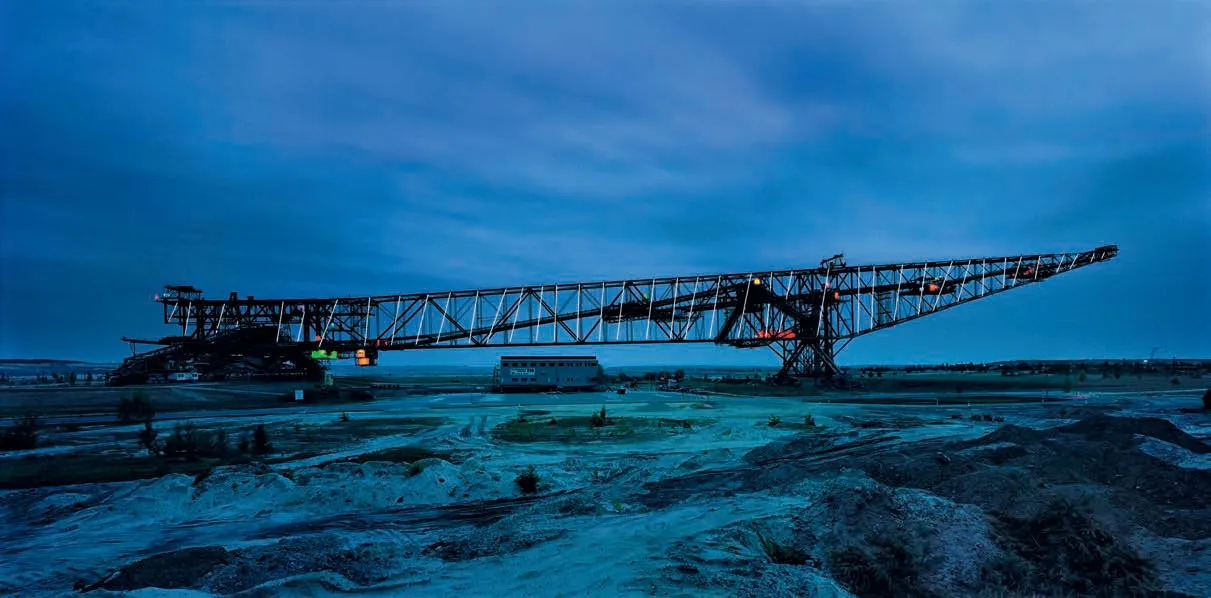
4 F60采矿桥这一卢萨蒂亚最大的典型采矿机器被改造成了一个步入式游客矿井和声光雕塑/The largest mining machine typical of Lusatia, the F60 conveyor bridge, was converted into a walk-in visitor mine as well as into a light and sound sculpture(摄影/Photo: Gerhard Kassner)
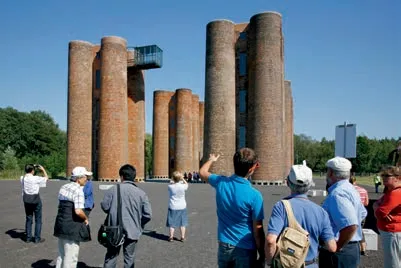
5 劳赫哈默原焦化厂的塔式生物滤池。前大型焦化厂的生物污水处理厂已经转变为具有独特工业建筑的探险和活动场所/The Biotowers of Lauchhammer. A biological sewage treatment plant for the former large coking plant has been transformed into an adventure and event location with unique industrial architecture(摄影/Photo: Thomas Kläber)
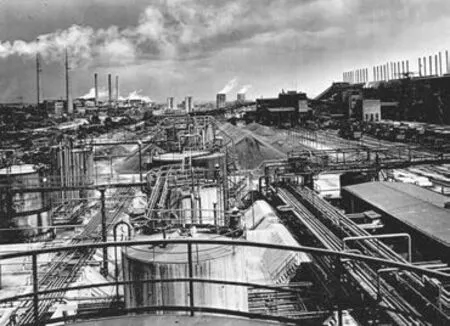
6 劳赫哈默原焦化厂的历史照片,塔式生物滤池在其后方,生物废水处理厂为工业用水服务/Historic view of the coking plant in Lauchhammer with the biotowers in the back, serving biological wastewater treatment plant for industrial waters(图片来源/Source: Disos archive)
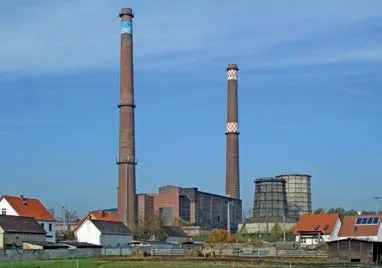
7 普莱萨发电厂。令人印象深刻的普莱萨发电厂已有80多年的历史,被认为是欧洲最古老的褐煤发电厂,该发电厂保留了原有的结构。直到1992年,该计划才产生电力。这个“工作大教堂”现在向游客开放/Plessa power station.The impressive Plessa power plant, which is over 80 years old,is considered to be the oldest lignite-fired power plant in Europe, which has been preserved in its original structure.Until 1992, the plan produced electricity. This "Cathedral of Work" is now open to visitors(摄影/Photo: Johannes Lange,2007)
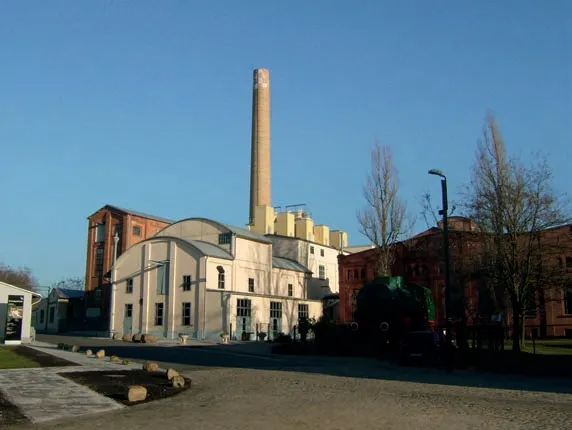
8 路易丝煤球厂。路易丝的工业纪念碑,作为一个前煤球厂,不仅是一个能源教育机构,也是一个生产生物炭的能源农场。该址属于“卢萨蒂亚工业遗产能源之路”的旅游路线/Briquette factory LOUISE The industrial monument LOUISE -a former briquette factory - is to house not only an energy educational institution but also a producing energy farm for biochar. The site belongs to the touristic route "Lusatian Energy Route of Industrial Heritage"(摄影/Photo: Cornelia Rumpf, 2006)

9 马尔加田园城市。马尔加曾被建设为工程定居点,如今是德国最古老的田园聚落。 它在铁幕落下后重建,从此焕发出新的辉煌。/The Garden city Marga. Marga has been built as works settlement and is today the oldest garden settlement in Germany. It was reconstructed after the fall of the iron curtain and has shone in new splendour ever since(摄影/Photo: Radke LMBV, 2007)

10 卢萨蒂亚湖区鸟瞰/Aerial view of Lusatian Lakeland(摄影/Photo: Radke LMBV, 2008)
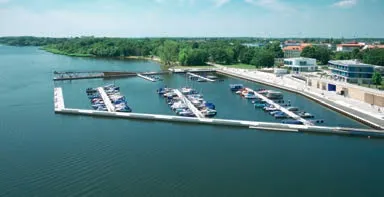
11 森夫滕贝格码头。凭借其独特的形状,港口将为前褐煤之都森夫滕贝格(一个拥有24,500名居民的城市)的新形象做出贡献。这是通过获奖者柏林bgmr景观设计事务所的设计实现的/The city habour of Senftenberg. With its characteristic shape, the harbour was to contribute to a new image for the former lignite capital: Senftenberg, a city of 24,500 inhabitants. This was achieved by the design of firstplaced landscape architects bgmr from Berlin (摄影/Photo: Mario Hambsch)

12 获奖者柏林bgmr景观设计事务所的森夫滕贝格码头设计效果图/The city habour of Senftenberg - visualisation of the competition winner bgmr, Berlin
评论
刘伯英:IBA SEE是继IBA埃姆舍尔之后又一个成功的传统工业区复兴项目,它被分解为30个子项,分别建立合作伙伴关系进行实施。将大面积露天矿坑注水形成湖泊景观,组织水上观光和沿岸体验,生态得以恢复,并成为大型郊野公园。F60这座“躺着的埃菲尔铁塔”成为纪念碑。项目突出了经济、社会、文化、环境等问题的综合解决,最终让一个生态破坏、环境污染、人口大量流失的衰退地区,实现了经济、文化、社会、旅游的综合复兴,让居民重拾自信,成为世界矿业城市复兴的典范。
薄宏涛:随着东西德统一,能源中心的迁移和能源产业的升级(天然气),传统褐煤生产基地的卢萨蒂亚面对了必然的衰退。10年的IBA在德国工业遗存更新领域展现了极大的城市动员能力和专业导向作用,在卢萨蒂亚的更新进程中,以保持和呈现工业历史线索的方式与矿坑自然湖泊修复策略结合,无论是有如外星飞船般宏大尺度的排矸桥,还是如神庙柱廊般伫立的生物塔,抑或是至今仍能在参观者面前隆隆生产煤球的厂区,都为区域的工业考古现场提供了明晰的标志物。而在广袤的绿野、葡萄园和清湛的湖面下,被掩埋的焦化厂、淹没的露天矿坑都呈现了从工业图景向自然图景的回归。
Comments
LIU Boying: IBA SEE has become another successful revitalisation project for the traditional industrial area after the IBA Emscher project. It is broken down into 30 sub-items, and each of them was completed with the partnership involved. The huge open-air pit became a lake landscape with the help of water injection. This not only allows visitors to enjoy both boat tours and coastal activities,but also contributes to the ecological restoration,thereby eventually transforming the pit into a large country park. F60, like the Eiffel Tower laid down, has now become a monument. This project presented a comprehensive solution to the issues including those that affect the economy, society,culture and environment, which ultimately enabled a depressed area with the problems of ecological damage, environmental pollution and population loss to achieve the integrated rejuvenation of the economy, culture, society and tourism. It helps the inhabitants regain confidence, while serving as a model of the revitalisation of mining cities in the world. (Translated by Dandan Wang)BO Hongtao: With the reunification of East and West Germany and the relocation of energy centres and upgrade of energy industry (natural gas), the traditional lignite production base of Lusatia is seeing inevitable decline. Ten years of IBA activities have demonstrated maximum level of urban mobilisation and professional guidance in the field of German industrial heritage renewal. The revitalisation of Lusatia is noted for its combination with the restoration strategy of mine pits into natural lakes by preserving and presenting traces of industrial history. Notwithstanding a huge conveyor bridge reminiscent of an alien spacecraft, or biotowers that stand like solemn temple columns, or even factories that still pump out briquettes in front of visitors today, they make up distinct landmarks in the district's industrial archaeology site. In the extensive green field and vineyards as well as beneath crystalline lakes, buried coking plant and submerged open mine pits signify a return from the industrial landscape to a natural one. (Translated by SHANG Jin)
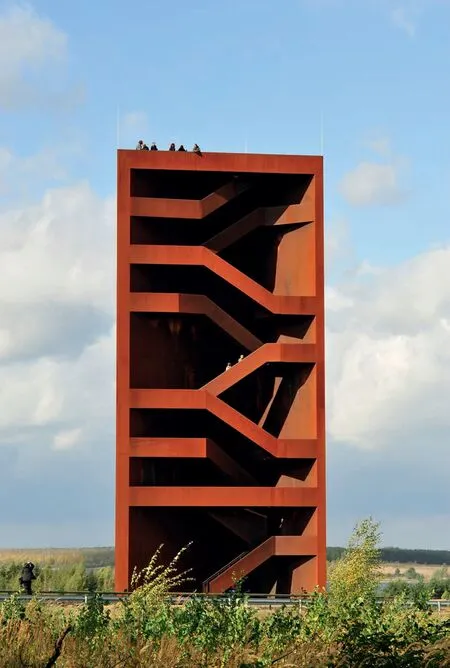
13 卢萨蒂亚湖区地标“锈甲”。来自慕尼黑的建筑师斯特凡·吉尔斯赢得了人造卢萨蒂亚湖区地标象征的设计竞赛/The Landmark Lusatian Lakeland - the "Rusty Nail".The architect Stephan Giers from Munich won the competition for a landmark symbolising the entire manmade Lusatian Lakeland(摄影/Photo: Christina Glanz)
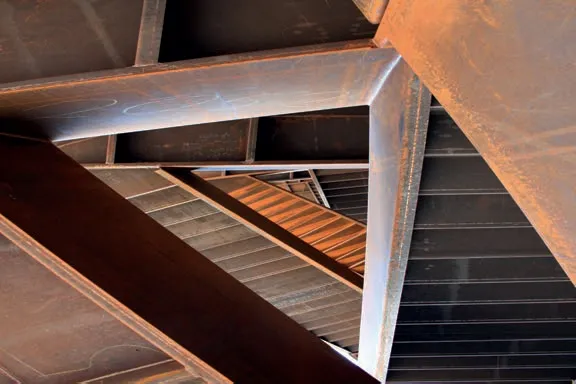
14 卢萨蒂亚湖区地标的楼梯/Staircase of the landmark Lusatian Lakeland(摄影/Photo: René Greger, 2008)
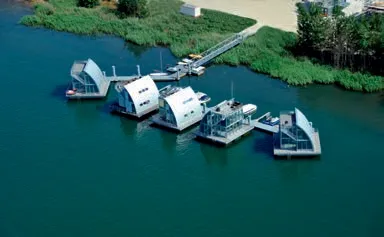
15 漂浮建筑。由于褐煤和其他工业,卢萨蒂亚具有许多工程和创新精神。这种精神被新勃兰登堡工业大学的漂浮建筑研究所进一步发展/Floating architecture. Lusatia has a lot of engineering and innovation spirit due to lignite and other industries. This spirit is further developed by the Institute for Floating Buildings of the BTU Cottbus-Senftenberg(摄影/Photo: Professional photo Kliche)
项目信息/Credits and Data
地点/Location: 德国卢萨蒂亚/Lausitz, Germany
主持建筑师/Principal Architect: Rolf Kuhn
设计团队支持/Team Consisting: 建筑设计师,景观设
计师,经济学家,城市规划师,技术助理/Architects,landscape designers, economists, City- and Urban planners,and technical assistants
场地面积/Site Area: 400hm2
造价/Cost: 4400万欧元/44M EUR
设计与施工时间/Period of Design and Realisation: 2000-2010

